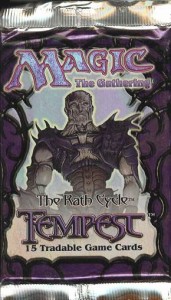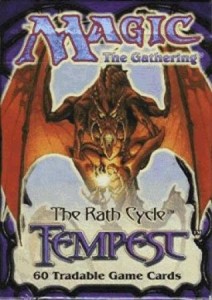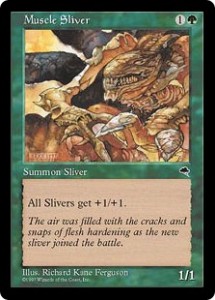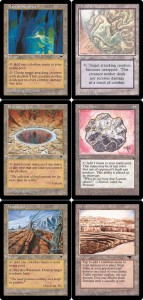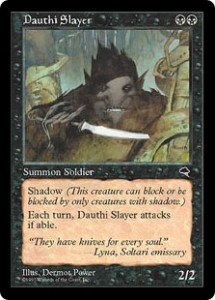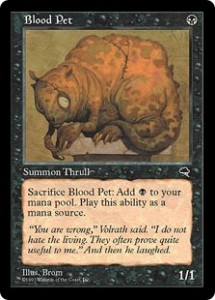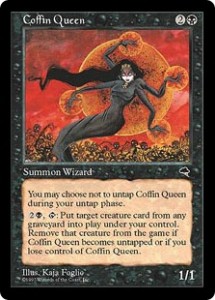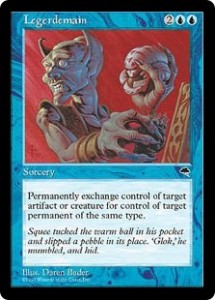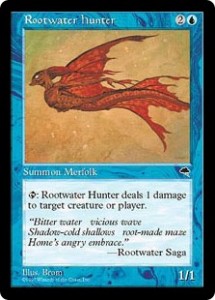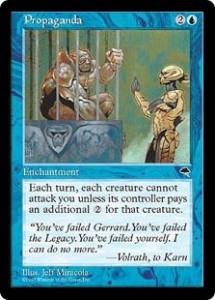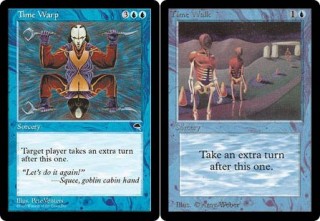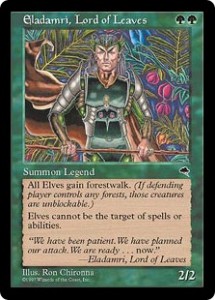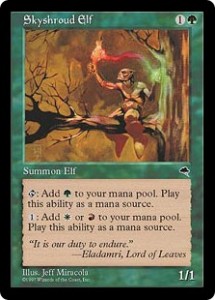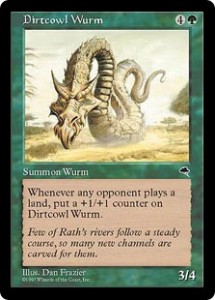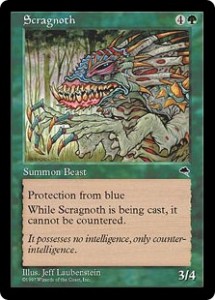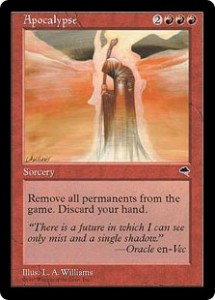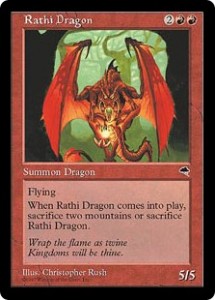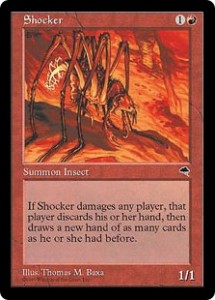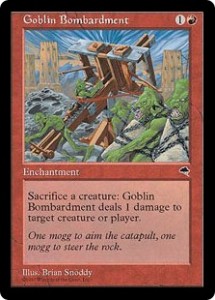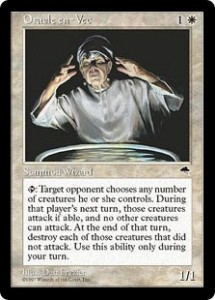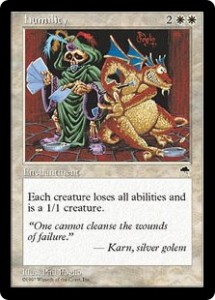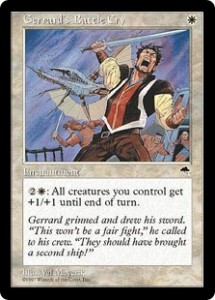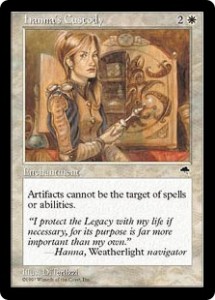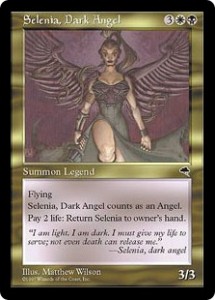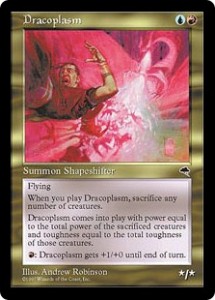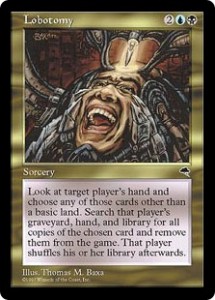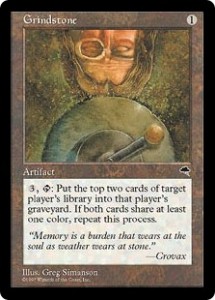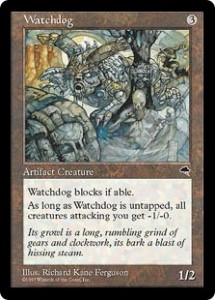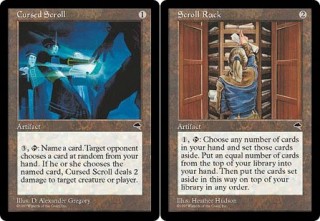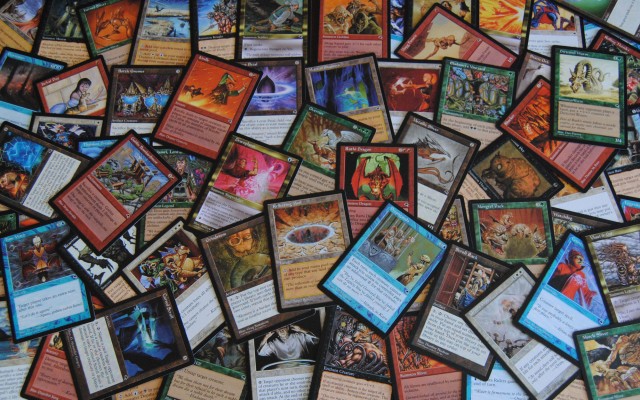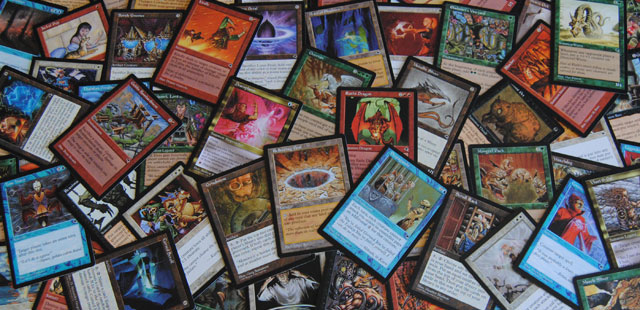
An Introduction to Tempest
Tempest was released in October of 1997 and it changed the game, or at least deck building and strategy in innumerable ways. It was the first set of the Rath Block, the name given to the Tempest block. Shadow and Buyback were two new rules added to the landscape of Magic: The Gathering from the set, while Phasing and Flanking were not present having, as it seemed, been contained to just the Mirage block.
Tribal decks were coming back in large part to the number of tribes that were printed in this stand alone expansion; Angels, Dragons, Elephants, Elves, Goblins, Licids, Merfolk, Shapeshifters, Soldiers and Wizards.
The set was also a coming out party for the new tribe of Slivers. Tempest also introduced a few cycles (cards that appear in each color); in addition to the Licids and Slivers, there were the Medallions and every color had two cards that would seriously damage a targeted opposing color.
Like Mirage and Ice Age, the last two stand alone expansion sets, Tempest consisted of 350 cards, with the same rarity breakdown of 110 commons, 110 Uncommons, 110 rares and 20 Lands.
The color breakdown was as balanced as any other set, 36 Lands, 53 Black cards, 53 Blue cards, 53 Green cards, 53 Red cards, 53 White cards, 10 Gold or Multicolor cards and 39 Artifacts.
Tempest contained 30 reprints from other sets, but notably of these 30 cards were the 11 that were reprinted from Portal, which was done, to allow players, who learned on Portal, to have a familiarity with some of the “expert” level cards. Tempest also had five functional reprints.
New family names and character tribes were introduced in Tempest, in addition to adding to some existing ones, like Dauthi, Eladamri, en-Vec, Mogg, Orim, Soltari, Starke, Thalakos and Volrath.
As new rules go, Shadow may have been the main headline during Tempest’s initial release, but Buyback was by far the more influential.
Buyback X (You may pay an additional X when you play this spell. If you do, put it into your hand instead of your graveyard as part of the spell’s effect.)
Shadow was basically flying by a different word. Shadow creatures can only be blocked by other creatures with Shadow, which is essentially the same as flying creatures can only be blocked by other creatures with flying.
Of course, there are exceptions, non-flyers and non-shadow creatures that can block creatures with those abilities, but by and large the two were the same. When it first came out, Shadow, even though it was, only an ability for 18 creatures, limited in color to just Blue, Black and White, was something you needed to prepare against, as everyone had one or two in their deck.
Buyback was only on 12 cards in the Tempest set, but it made all of them more powerful, because they could be used over and over again, if the Mana was available to you. Obviously, this could get out of hand, which is why most Buyback costs were two, while others were three or four Mana, in addition to the spell’s actual cost. None of the Buyback spells where anything new, they were just more useful, with the prospect of being used again and again.
Capsize to “return target permanent to owner’s hand,” Disturbed Burial to “return target creature card form your graveyard to your hand,” Elvish Fury to give “target creature gets +2/+2 until end of turn,” Invulnerability to “prevent all damage to you from one source,” and Searing Touch to deal “1 damage to target creature or player,” to name a few.
By themselves, the are fairly unremarkable cards, the likes of which we’ve seen in the game since it’s inception, but with Buyback attached, these can be more easily reused and thus replaced their non-Buyback counterparts in many decks.
The Licids were 1/1 creatures that could be turned into creature enchantments and back to creature form.
There were five, one for each color; Enraging Licid, which could make enchanted creature unaffected by summoning sickness for Red, Leeching Licid that could damage enchanted creature’ s controller during their upkeep for Black, Nurturing Licid which could be a Regeneration for Green, Quickening Licid which could be a Lance for White and Stinging Licid which could deal two damage to enchanted creature’s controller whenever the enchanted creature was tapped for Blue.
Like, Buyback, these as 1/1 weenies or as the enchantments themselves were unremarkable, but the ability to make them a creature or an enchantment on a whim, for the cost of one colored Mana, was what made them valuable. But the Licids, which could have had a big coming out party in Tempest, were overshadowed by the one tribe that took Magic by storm in the winter of 1997-1998; the Slivers!
But before we get there, Tempest, like Mirage, was released with four pre-made Theme decks, but varying a bit from the Mirage Theme decks, Tempest’s decks included many more cards that were of great value.
Deep Freeze a Blue/White control deck contained Avenging Angel, Emmessi Tome, Knight of Dawn and three Counterspells; The Flames of Wrath a straight Red deck, with the exception of Disenchant, contained Goblin Bombardment, Searing Touch, Kindle and Furnace of Rath; The Swarm a straight Green deck, again with a White exception, contained Aluren, Overrun, Elvish Fury and Recycle; and lastly there was The Slivers, which was a Black Blue deck.
The Slivers: Slivers, Slivers Everywhere
The Slivers were a new tribe consisting of weenie creatures, each with an ability that would be shared with every other Sliver in play, not just yours but every Sliver. Tempest launched the Slivers with 11 total Slivers; Armor Sliver, Barbed Sliver, Clot Sliver, heart Sliver, horned Sliver, Mindwhip Sliver, Mnemonic Sliver, Muscle Sliver, Talon Sliver, Winged Sliver and Metallic Sliver; that’s two for each color and one Artifact creature.
Although the Slivers, as a tribe, would grow throughout The Rath Cycle, these initial 11 gave you plenty to choose from. If you could get all 11 in play at once, you’re 1/1 Artifact Metallic Sliver would have enough ability to rival almost any creature that existed in the game, ever.
The standout Slivers from the first 11 were, Muscle Sliver, which gave all Slivers +1/+1, heart Sliver, which made all Slivers unaffected by summoning sickness, Winged Sliver, which gave them all Flying, and the 1/1 for one colorless Mana Metallic Sliver. As The Rath Cycle and Magic The Gathering continued with newer sets the Slivers as a tribe would grow to number over 90 creatures.
The Lands of Tempest: Reflecting and the Return of Pain and Slow Lands
The Land in Tempest mimicked the Land of Ice Age in that, of course there were the five Basic Lands, but there were also duals Lands, both Slow Lands; that didn’t untap during your next untap phase. and Pain Lands; that would give you one colorless Mana for free, but one of either of two colored options for one point of damage. The only difference between the Ice Age Pain and Slow Lands and the Tempest one’s is that the Tempest Land’s all come into play tapped, thus slowing down their production.
Aside from those, Ancient Tomb gave you two colorless Mana, but dealt you two damage, Ghost Town gave you one colorless Mana and could be returned to your hand during any other player’s turn for no cost, Stalking Stones a Land that for six colorless Mana could be permenently made into a 3/3 Artifact Creature and still remained a source of one colorless Mana.
But like always, something is going to stand out and with the Land of Tempest there were three exceptional Lands; Maze of Shadow, Wasteland and Reflecting Pool
Maze of Shadows was a Maze of Ith for Shadow creatures that also gave you the ability to Tap it for one colorless Mana, an ability not found on Maze of Ith. Both allowed you to untap target attacking creature to have it deal no combat damage this turn, but Maze of Shadow only targeted creatures with Shadow. Still, with the added bonus of being able to provide Mana, this was a great safeguard against Shadow if you didn’t have any Shadow creatures in your deck.
Wasteland was a Strip Mine for nonbasic Lands. When, Strip Mine was in it’s heyday, this would have seemed like a waste, but with the advent of so many nonbasic Lands in Magic from Fallen Empires, Ice Age, Homelands, Alliances, Mirage and many other sets, nonbasic lands were now common sights in decks, so the Wasteland was well used, although still not as useful as a good old Strip Mine.
Last, but certainly not least, was Reflecting Pool. This Land caused quite a stir as it was in essence a Fellwar Stone, that targeted you, in Land form. As with Fellwar Stone, Reflecting Pool could be tapped for any color of Mana that could be produced by Land already in play, but unlike Fellwar Stone which targeted Land your opponent controlled, Reflecting Pool targeted Land that you control, making it very effective in combination with Pain Lands, because it could give you the color you needed without the point of damage.
The Color Black in Tempest: Discard and Destruction with the Creatures and Spells to make it happen
Black was back to its usual tricks in Tempest with discard, reanimation, big creatures, tribes and general destruction with the added bonus of an army of Shadow creatures. Dark Ritual the staple Black card of all Black cards was back again to the relief of players of the color Black everywhere.
Discard had Coercion, which allowed you to look at target opponent’s hand to choose one card for them to discard and it was even given a Sliver in Mindwhip Sliver, which gave you the ability to sacrifice a Sliver to make a player discard a card at random.
Reanimator decks, were bolstered even further with Corpse Dance, Gravedigger, Living Death, Reanimate and Skyshroud Vampire which allowed you to discard a creature card to give it +2/+2 until end of turn, which was just another way to get that big creature into the graveyard as you wished. Disturbed Ritual was a Raise Dead with Buyback, which was cheered by all reanimator deck players.
Abandon Hope was perfect for reanimate and discard decks. For one colorless, one Black and X colorless Mana, you could discard X cards to look at target opponent’s hand and choose X cards for them to discard. This gave rise to the little used discard/reanimator deck, which could be very effective.
Shadow was very prevalent in Black with the Dauthi Clan; Dauthi Ghoul, Dauthi horror, Dauthi Maruader, Dauthi Mercenary, Dauthi Mindripper and Dauthi Slayer. For good measure Dauthi Embrace was an enchantment that could give any creature shadow until end of turn, so you could set loose any big creature on your opponent with the added benefit of Shadow.
There was no shortage of big creatures added to Black’s army in Tempest with Commander Greven il-Vec and Minion of the Wastes. Commander Greven, the Legend, was a 7/5 who needed to have a creature sacrificed when it was cast, but it had a built in Fear. Minion of the Wastes on the other hand was an expensive Trampler with a converted Mana cost of six, but when it came into play, you payed an amount of life that would be it’s power and toughness. So play it early on and pay eight life to make it an 8/8 trample that your opponent will fear.
It wasn’t all about big creatures, Black had quite a few smaller useful creatures as well. Blood Pet, hearkened the return of the Thrulls with the first Thrull printed since Fallen Empires, as a 1/1 for one Black Mana, that could be sacrificed to for one Black Mana.
Pit Imp was a functional reprint of Vampire Bats, Bounty hunter was a two turn Royal Assassin, but since the Royal was out of print, it was the best that could be used at the time and if you had two in play, it wasn’t a two turn Royal, it was a one turn kill combo, like Icy Manipulator and Royal Assassin used to be.
Coffin Queen was good for reanimator decks, but was really good in any deck with Black in it. It allowed you to pay a cost and Tap it to put any creature from any graveyard into play under you’re control. For straight Black destruction decks, this meant that you could beat your opponent with their own Shivan Dragon, once you killed it first or made them discard it.
And the Queen only cost two colorless and one Black Mana, and that was the activation cost too, so you could Dark Ritual for a first turn Coffin Queen, hymn to Tourach them on turn two and if you were lucky, you could have their big creature in play on your side for turn three.
The Queen was a solid enough card that it didn’t have to be put into a discard or Millstone deck or a even a straight Black deck. Creatures die and with the Queen in play, you have access to all of your opponent’s deceased.
Rats of Rath was an extremely useful Rat, because it allowed you to destroy target artifact, creature or land you control, so for those upkeep killers like Juzaam Djinn, you could get rid of them before they killed you.
There were also some knights and other small creatures, but Tempest gave Black even more ways to boost them, beyond howl from Beyond. Endless Scream for example was a howl from Beyond that was a creature enchantment, so that +X/+0 was permanent. Sadistic Glee made enchanted creature a Sengir Vampire and Spinal Graft gave target creature +3/+3, but the creature was destroyed if it became the target of a spell or ability.
Sarcomancy heralded the return of the Zombie deck, which had existed since Zombie Master in the original core set. But now, you had a one Black Mana enchantment, that put a 2/2 Zombie token into play, if no Zombies were in play, it dealt one damage to you during your upkeep, so Wrath of God was something to watch out for.
Black’s arsenal of destruction was not diminished by any stretch in Tempest. Death Pits of Rath made any creature brittle, because if it was in play any creature that was dealt any damage was destroyed and could not be regenerated. Extinction was a tribal Wrath of God, an extremely useful card for targeting your opponent’s tribal deck and clearing the way for your own army. Evincar’s Justice was a two damage, Buyback Pestilence Sorcery and Rain of Tears returned Land destruction to Black.
Fevered Convulsions was an enchantment similar to Serrated Arrows, only it was not limited to three -1/-1 tokens. It was only limited by your ability to pay it’s two colorless and two Black Mana activation cost. While Dregs of Sorrow sorrow was also fairly expensive it had a rich payoff. four colorless, one Black and X Mana, to cast, it allowed you to destory X target nonblack creatures AND draw X cards. This kind of card draw and destruction in one, was a thing of beauty to most players of Black.
The Color Blue in Tempest: Counters, Control, Shadow and Time
Tempest’s Blue was of course highlighted by counters; the one and only Counterspell along with Power Sink, Spell Blast and Dismiss a Counterspell with a cantrip. Plus Interdict, which could “counter target artifact, creature, enchantment, or land ability requiring an activation cost,” and had the added bonus of being a cantrip, as well.
Nine years before Suspend would exist as an ability for Magic in Time Spiral, Ertai’s Meddling gave players a taste of what that might be like. It wasn’t a Counterspell, but it did put X delay counters on target spell, to delay it until the final counter was removed. Each counter was removed during the caster’s upkeep. This essentially was the forebear to Suspend.
Blue had two extremely useful Buyback spells; Capsize and Whispers of the Muse. Capsize was a Boomerang with Buyback, which could be deadly if the caster had the Mana to constantly pay the Buyback cost, whereas Whispers of the Muse was Buyback card draw, allowing you to draw one card, although the Buyback cost was the most expensive at that time with a cost of four colorless Mana.
Blue’s ability to copy and steal was not diminished in Tempest. Duplicity, Escaped Shapeshifter and Unstable Shapeshifter gave Blue players plenty of army arsenal, depending on what else was in play. Copying something is good, but stealing is better and with Legacy’s Allure for creatures and Steal Enchantment there was more cause to allow your opponent to cast something.
Of course, you could bolster the cult favorite “exchange deck” which already had Gauntlets of Chaos with Legerdemain. These deck’s were not common, but could be extremely hurtful, by exchanging something with a massive upkeep or something that damages its controller with something that does not.
Blue’s creature stable was enhanced with a few useful creatures, as well as more Merfolk and the Thalakos clan which contained all of Blue’s Shadow creatures.
Fylamarid was a flying 1/3 with a built in Blue Fear that had the ability to turn creatures Blue and make them unable to block it. Mawcor was a BIG 3/3 flying Tim, Skyshroud Condor was a cheap 2/2 flyer that couldn’t be cast unless you already cast a spell this turn. Tradewind Rider allowed you to tap to creatures to Boomerang something and Wind Dancer could give target creature flying until end of turn.
The tribe of Merfolk had more numbers added to their ranks with Manta Riders and the Rootwater clan. Manta Riders were of note, because they were a 1/1 for one Blue Mana that could be given flying until end of turn.
Of the Rootwater clan; Rootwater Matriarch could allow you to steal any creature with an enchantment on it, and Rootwater hunter was a functional reprint of Prodigal Sorcerer, but as a Merfolk, could be given boosts from other Marfolk and was a much praised addition to the tribe. Meanwhile, Thalakos was a clan that housed all of Blue’s Shadow creatures; Thalakos Dreamsower, Thalakos Mistfolk, Thalakos Seer and Thalakos Sentry.
But for Blue in Tempest it was about power spells and that was something Blue was given in this set with abundance.
Intuition was an great card advantage that allowed you to choose three cards from your library and have your opponent choose one for you to draw, while the other two went into your graveyard. Mana Severance also allowed you better card draw late in games, by removing any number of land cards from your library, if you have enough Land in play, making your draws more valuable as you wouldn’t be drawing unnecessary Land.
Precognition was also a card draw advantage as a kind of Blue Sylvan Library on your opponent, allowing you to look at the top card of their library during your upkeep and then giving you the choice to leave it there or move it to the bottom of their library.
Targeting your creatures with Shadow Rift was great because it gave target creature Shadow and had a cantrip attached to it. While Shimmering Wings gave enchanted creature flying and could be returned to your hand for one Blue Mana. Additionally, Twitch was a Twiddle with a cantrip, while Whim of Volrath was a copy of Ice Age’s Mind Bend with a Buyback.
Speaking of Volrath, Volrath’s Curse was a Pacifism that you could bounce back to your hand in order to target a more harmful creature, which is a huge advantage for Blue. But of all of Blue’s power cards, three stood above and beyond; Meditate, Time Warp and Propaganda.
Meditate was simple and straightforward allowing you to skip your next turn to draw four cards. For Stasis and other lockdown decks this was quite the boon, as was the next power card: Propaganda.
Propaganda; “Each turn, each creature cannot attack you unless its controller pays an additional 2 for that creature.” This was made all the more powerful, when put in a properly constructed Propaganda deck, because once two, three or even a full playset of four Propagandas were cast, attacking with even one creature was expensive for your opponent.
And when paired with Meditate, it didn’t matter if you skipped your turn to draw four cards, you were safe, depending on how much Mana your opponent had. Except that most Propaganda deck’s had Icy Manipulator to deal with the creatures that were paid for.
But the crème de la crème of the Tempest Blue Power cards was the reincarnated Time Walk of Time Warp. First off, they printed it because they fixed it from being one of the “Broken” Power Nine, because now it cost three colorless and two Blue Mana, as opposed to it’s original incarnation of Time Walk which only cost one colorless and one Blue Mana.
Despite it’s cost, old school player’s were so happy to have it back, in spite of it’s high cost, it was widely used.
This is a card that gives you another turn but it was more than that, because unlike Time Walk “take extra turn after this one,” Time Warp said “target player takes an extra turn after this one,” which meant if your opponent had something that was damaging them during their upkeep, you could force them extra painful upkeep. This added ability was probably tweaked because of the high casting cost, but the versatility made it for the card’s uses were great and well worth the cost.
The Color Green in Tempest: Elves, Recycling and the Trampling hordes
Green was not, as would have been thought, completely about the Elves and weenies in Tempest. There were powerful spells and big creatures that stole some of the show from the Elves, but still it’s the Elves where we will start.
The Elves of Tempest, were the first Elves in the tribe to have a leader in Eladamri, Lord of Leaves. Eladamri was a Legend who gave all Elves Forestwalk and stated that “Elves cannot be the target of spells or abilities.” This didn’t stop Wrath of God, Jokulhaups and Extinction, but then only Counterspells can really stop those spells.
Eladamri, brought his vineyard, Eladamri’s Vineyard, with him to the Tempest set as well. The Vineyard was an enchantment that stated, “at the beginning of each player’s main phase, add two Green Mana to that player’s Mana pool.” This may not seem like much, but remember Mana burn was still in the rulebook at that time, so if the Mana wasn’t spent damage would be taken.
Sure, the army of Elves grew with Elven Warhounds, Seeker of Skybreak and Skyshroud Ranger, but the standout elf of the set was Skyshroud Elf. Skyshroud Elf may be comparable only to Mirage’s Quirion Elves, but it’s better than that. Skyshroud Elf can be tapped for one Green Mana, but colorless Mana can be pumped through it to get you White or Red Mana.
This is similar to Fallen Empire‘s Initiates of the ebon hand and Farrelite Priest, only Skyshroud Elf doesn’t die if you pump more than three Mana through it. This is extremely useful, especially for creature heavy Red/Green decks, but of course, it’s not always about the Elves.
Big creatures were abundantly found in Tempest’s Green cards, as well. Verdant Force is a 7/7, that gives each player a 1/1 Saproling token during their upkeep, while Krakilin is a dangerous X casting cost regenerating beast, that has power and toughness equal to X. This is dangerous because of Green’s ability to create Mana at an alarming rate.
Crazed Armodon is a 3/3 that can go on a suicide mission as a 6/3 with trample that gets destroyed at the end of that turn. Heartwood Giant gave Green decks something useful to do with all of that extra Land, later in games, by sacrificing it to the Giant for two damage dealt to target player. Mongrel Pack was a threat as a 4/1 that when it died put four 1/1 hound tokens into play, but the big boy on the block was Dirtcowl Wurm.
The Wurm was a great addition to the already formidable Ehrnageddon or Squatageddon decks, because it was a 3/4 that received a +1/+1 counter whenever an opponent plays a Land. This meant, that if cast right before the Armageddon, it could be huge after a short time, as your opponent tried to build up their Mana sources again.
There were also useful small creatures in Green, as there always are. Pincher Beetles was a 3/1 that couldn’t be the target of spells or abilities, Rootwalla was a 2/2 that could be given +2/+2 once per turn, while Fugitive Druid was a good addition to the Rabid Wombat / Verduran Enchantress combo, because you could draw a card for any enchantment cast on the druid, while waiting to draw the Wombat.
How about creatures that protect you from specific colors or abilities. Bayou Dragonfly had protection from black, while heartwood Dryad protected you from creatures with Shadow and was aided further by Reality Anchor, a spell that removed Shadow from a creature until end of turn and had a cantrip. These were all good, but one color protection card stood above the rest, the anti-blue; Scragnoth.
Scragnoth was a fairly expensive 3/4 that had protection from Blue and the added ability of “while Scragnoth is being cast, it cannot be countered.” This was as good as an anti-Blue spell could possibly get.
Once those creatures were in play you could use the rebuilt Web in the form of Frog Tongue, which traded the +0/+2 buff for a cantrip and also Elvish Fury, the slightly smaller Giant Growth with Buyback. Of course it wasn’t all creatures for Green.
Natural Spring was a discounted Stream of Life for eight, Needle Storm was a four damage hurricane that didn’t hit players, Winter’s Grasp was simple Land destruction similar to Ice Storm from Unlimited with the same converted Mana cost, but with a different cost breakdown and Respite was a Fog with life gain. Harrow allowed you to sacrifice a Land to search your library for two basic lands to put into play, furthering Green’s prospects at having a massive Mana pool to draw from.
On a more permanent level there were plenty of useful enchantments to go around.
Earthcraft was a source of Mana by allowing you to tap an untapped creature to untap target basic Land, Mirri’s Guile was a Sylvan Library without the ability to draw an additional card, Nature’s Revolt made all Lands 2/2 creatures that still counted as lands, and Root Maze was a Green Kismet only targeting Lands and Artifacts.
Recycle was an interesting concept in skipping your draw phase, so that you may draw a card, whenever you play a card. However, during your discard phase, you must choose and discard all but two cards. This being a Green enchantment, there is a very good chance, that if you cast it with more than two cards in your hand, you should be able to cast everything in your hand anyway.
Broken Fall was the ultimate in creature protection. It was a global enchantment that could be returned to your hand to regenerate target creature, thus allowing you to recast Broken Fall again, should it be needed. This was simply a cheaper and unofficial form of Buyback.
All of this was great for Green, giving new life to old deck concepts, but there were two cards in Tempest for Green that towered above the rest; Overrun and Aluren.
Overrun is a simple card, both powerful and expensive. For two colorless and three Green Mana, “all creatures you control get +3/+3 and gain trample until end of turn.” In long weenie versus weenie or Elf versus Elf decks, drawing this card was like winning the tiebreaker.
It’s not hard to image an Elf or weenie deck, 12 turns in with eight 1/1’s in play, but with Overrun, at least for one turn, you’d have eight 4/4’s with trample. This card was commonly used to end the game, because, frankly it usually did.
Aluren was a fairly elementary enchantment had one card not existed that made it simply a combo made in weenie deck heaven. Aluren said, “any player may play a creature card with total casting cost 3 or less whenever he or she could play an instant and without paying its casting cost.”
This was good news, but when paired with the making creatures everlasting Enduring Renewal from Ice Age, it meant that small creatures could be cast, die and cast again, many times in one turn. And with Red gaining Goblin Bombardment, this meant more chances at an infinite damage combo.
The Color Red in Tempest: Goblins breed Destruction with Bombardment
Red’s destructive power was out in force for Tempest. Destruction, direct damage, big creatures, little creatures and buffs for creatures as well as one power card that changed the game and had many decks created around it.
As far as destruction is concerned, Aftershock could destroy an Artifact, creature or Land, but the flexibility of the spell came with the cost of dealing three damage to you. Scorched Earth allowed you to pay one Red and X Mana and discard X Land cards to destroy X Lands. No Quarter simply stated that if any creature blocks or is blocked by a creature with lesser power, the creature with the lesser power is destroyed. But the those are target specifics, if you want to just clear the board and start over, Tempest had that for Red in Apocalypse.
Apocalypse cost two colorless and three Red Mana to “Remove all permanents from the game. Discard your hand.” Of course, discarding your hand, meant you were at a disadvantage for building yourself back up, but if you have no choice, this is the ultimate board clearing card.
Direct damage was given another boost in its repertoire in Tempest. Ancient Ruins dealt each player one damage during their upkeeps for each artifact they controlled, Deadshot tapped a creature and had it deal damage equal to it’s power to another creature, Rolling Thunder was a Fireball with one additional Red Mana in the cost that didn’t have to divide the damage evenly among its targets and Opportunist was a 2/2 that could be tapped to deal one damage to a creature that was already damaged this turn.
Lightning Blast was just a discounted X Red direct damage spell costing a converted four mana to deal four damage to target creature or player and Lightning Elemental was a 4/1 that was unaffected by summoning sickness and might as well have been a Sorcery as opposed to a Summon. If you wanted to deal with Shadow creatures, you could use Wall of Diffusion, which could block creatures with Shadow, or you could blast them, as they were all fairly small creatures, with Shadowstorm which dealt two damage to each creature with Shadow.
Red also had its very own Storm Seeker in Sudden Impact and the pinging of Searing Touch, a one damage Buyback Instant that was extremely useful in its own right, but there were two cards for direct damage players that took the cake; Kindle and Furnace of Rath.
Kindle cost one colorless and one Red Mana and dealt 2 plus the number of other Kindle cards in all graveyards damage to target creature or player. This was something to think twice about, if you both had Kindles in your deck, because in theory the last Kindle cast would deal nine damage for two Mana, that’s a bargain at twice the price.
The other boost to direct damage was Furnace of Rath, which double all damage assigned to any creature or player. Now, this was a scary thing to play if your opponent was playing Red or Black, but for the sake of White, Blue and Green, it wasn’t as bad for you as it was for your opponent.
Red’s preeminent tribe the Goblins, had its very own clan in Mogg with Mogg Conscripts, Mogg Fanatic, Mogg Raider and Mogg Squad. Of course the Mogg Fanatic is the highlight, being a 1/1 that costs one Red Mana and can be sacrificed to deal one damage to target creature or player, but it wasn’t all about the Goblins.
Rathi Dragon followed in the footsteps of Alliances‘ Balduvian horde, being a 5/5 for two colorless and two Red Mana with an additional cost to cast. Of course for the flying Rathi Dragon the cost was to sacrifice two Mountains, which is a lot steeper than the discard a card at random for the horde, but again, the Rathi is a Dragon with Flying.
Wild Wurm and Starke of Rath were both interesting concepts. Wild Wurm was a 5/4 for the discounted cost of three colorless and one Red Mana, but when it came into play you had to flip a coin to see whether it would remain in play or get bounced back to your hand. Starke of Rath on the other hand could be tapped to destroy target artifact or creature, but then ownership of Starke of Rath was transferred to that permanent’s controller. Which means you might get Starke of Rath back, but at what cost?
Chaotic Goo, like Wild Wurm, had a coin flip associated with it. It was a 0/0 that came into play with three +1/+1 counters on it. During your upkeep, you may, which means you don’t have to, flip a coin. If you win the flip add a +1/+1 counter to the Goo, otherwise remove one.
Magmasaur was also a player preference. It was also a 0/0, that came into play with five +1/+1 counters on it, but during your upkeep, you had to either remove a counter or sacrifice it to have it Earthquake for the number of counters on it. On the plus side, if you let it go off on the first upkeep you have with it, it’s one Mana cheaper than a five damage Earthqauke would have been.
Firefly was a mini 1/1 Shivan Dragon, while Fireslinger was a Tim that also damaged you when it was tapped for its ability. Renegade Warlord was a 3/3 with first strike that when it attacked gave every other attacking creature a +1/+0. Imagine what could be done with two Renegade Warlords in play and an Overrun? All other attacking creatures would get +5/+3 and trample.
It didn’t have to be the Renegade Warlord or teaming up with Green to boost your Red creatures, Tempest’s Red had a few creature buffs of its own.
Blood Frenzy gave target attacking or blocking creature +4/+0 until end of turn, when it would be destroyed, Crown of Flames was a Firebreathing that could be returned to your hand for a cost, if the creature died or, if you wanted to enchant a different creature. Meanwhile, only on the offensive end, Tangarth’s Rage gave enchanted creature +3/+0 when attacking and -2/-1 otherwise.
There are two curious enchantments that didn’t get a lot of play when Tempest was released, although they deserve some respect; hand to hand and Tooth and Claw. Hand to hand, “instants and abilities requiring an activation cost cannot be played during combat,” which makes it simply my guy vs. your guy.
Then there’s Tooth and Claw which allowed you to sacrifice two creatures to put a 3/1 Carnivore token into play. I know it’s a one for two, as opposed to Fallen Empire‘s Goblin Warrens, which is a three for two, but you could be sacrificing two 1/1’s for a 3/1, and I’m not sure that’s always a bad thing. Still, neither got much play.
The most over-hyped card in Tempest’s complete library was, and probably still is, Shocker. This 1/1 insect said, “if Shocker damages any player, that player discards his or her hand, then draws a new hand of as many cards as he or she had before.”
The problem was, most people attempted to play four in their deck, with four of Weatherlight‘s Fire Whip and tried to make it work, but they always forgot, a Fire Whip may help you get to the opponent, but it doesn’t help the fact that it’s still a 1/1. As such, it was fairly easy to deal with.
Hype is one thing, that Goblin Bombardment lived up to. Fruity Pebbles, Cocoa Pebbles, pick your cereal deck, it doesn’t matter, this card made it’s way through the tournament circuit with vengeance.
Whether it was Fruity or Cocoa, the objective was the same, get out Goblin Bombardment, with an Enduring Renewal and a zero casting cost Ornithoper or Shield Sphere.
Of course, this did work with Aluren, as well, but it was far faster to not have to wait for the Aluren if you could just complete the combo with three cards. It doesn’t matter what you’re telling yourself right now, if you played in tournaments when Tempest came out, these deck’s were as common as basic land, it was that prevalent. To this day I still have a Fruity Pebbles deck and a Cocoa Pebbles deck, that haven’t really changed since I built them, because they are extremely fun to play.
The Color White in Tempest: Everything you need Offense, Defense and Protection
Tempest’s White lineup seemed to have more balance in attack and defense than other sets of its time. I say that because, although White always had some destruction in its arsenal, the inclusion of the Soltari, White’s clan of Shadow creatures, was much more offensive and they numbered enough for me to have made the first statement.
White’s creature lineup, was formidable. Another Atog was printed with Auratog, which was boosted by sacrificing enchantments. Avenging Angel boosted the Angel tribe and Knight of Dawn did the same for the tribe of Knights. Master Decoy was a 1/2 soldier with the ability to Tap target creature and Oracle en-Vec was a kind of massive Nettling Imp.
As I mentioned earlier, the Soltari clan provided White with Shadow creatures; Soltari Crusader, Soltari Emissary, Soltari Foot Soldier, Soltari Lancer, Soltari Mong, Soltari Priest and Soltari Trooper. White didn’t just rely on the Soltari to protect itself from Shadow, a new Circle of Protection was created for Tempest in Circle of Protection: Shadow.
The rise of the White weenies was again trumpeted with Tempest as it had with many prior sets as well. Field of Souls was an enchantment that gave you a 1/1 flying Essence token every time a creature was put into your graveyard from play. Pegasus Refuge was an enchantment that allowed you to discard a card, pay two colorless Mana and put a 1/1 flying Pegasus token into play.
Protecting these weenies, could very well fall into the charge of Orim, Samite healer, the Legend, which counted as a Cleric and unlike the basic Samite healer, could prevent not one, but three damage to any creature or player. In fact, Orim was responsible for one of the more interesting combos in Tempest; humility and Orim’s Prayer.
Humility, “each creature loses all abilities and is a 1/1 creature,” and Orim’s Prayer, “if any creatures attack you, gain one life for each attacking creature,” made for a great combo, because without boosts, you’d be able to leave all the 1/1’s unblocked and then take the same amount of damage that you gained in life, leaving you exactly where you were to begin with.
If you wanted to boost your white 1/1’s that had no abilities thanks to the humility, you could use the standards of Crusade or Angelic Voices or the just minted Gerrard’s Battle Cry, which was an enchantment with the ability for two colorless and one White Mana to give all creatures you control +1/+1 until end of turn and it was an enchantment, which meant if you had the Mana, you could pay for the ability two or three times.
All of that is well and good, but White had some standard protections too. Flickering Ward was like the Wards before it, only you could choose the color of protection when it was cast and you could return it to your hand, to recast it with protection from another color, should you choose.
Gallantry was a smaller Righteousness at just +4/+4, but had a cantrip and hero’s Resolve was a holy strength with a bigger toughness boost at +1/+5.
Invulnerability protected you from all damage dealt from one source and had Buyback, Safeguard was an enchantment with a two colorless and one White Mana activation cost to make target creature deal no combat damage this turn and Worthy Cause was last resort life gain by sacrificing a creature to gain life equal to its toughness and it had Buyback.
Marble Titan was a 3/3 Meekstone in creature form, while Repentance was a bit more of an offensive play making target creature do damage to itself equal to its power with the only drawback being that it was a Sorcery and not an Instant.
It’s apparent as the sets continued to poor out of Wizards of the Coast that Artifacts were beginning to play a much bigger role in the game. When I started playing during Fallen Empires, Artifacts were on average a much smaller percentage of one’s deck than they had grown to be by the time of Tempest’s printing.
So it was no shock that the very handy hanna’s Custody was printed, which simply stated “Artifacts cannot be the target of spells or abilities.” Although, this did work for all Artifacts and not just your Artifacts.
Wrath of God was always a great equalizer for White, but the tweaked Winds of Rath, which cost one more colorless Mana than the Wrath of God, tipped the scale in your favor, if you built for it.
Winds of Rath only destroyed all creatures with no enchantments on them, so if you where enchanting your creatures, you could be looking at the card that would kill most of your opponent’s creatures and spare most of yours.
Winds of Rath was simply the most fun you could have with mass creature destruction. Plus with the addition of all of the enchantments in Tempest that could be bounced back and recast, you could really have more control over which creatures in your army would die, if you didn’t have enough enchantments to go around.
The Gold of Tempest: Legends, Shapeshifters and a Lobotomy
Tempest only contained ten Gold or Multicolored cards, and not all were the most useful. Sky Spirit, Segmented Wurm and Ranger en-Vec were hardly if ever used, but the other seven saw regular play.
Selenia, Dark Angel, was a 3/3 flying Legend, who still counted as an Angel could be returned to your hand for a cost of two life. Spontaneous Combustion was an Instant that said, “Sacrifice a creature: Spontaneous Combustion deals three damage to each creature.” It’s very important to note that following the word “creature” is a colon, which meant you could sacrifice as many creatures as you wanted to, so if you needed to kill the 6/6, then sacrifice two creatures, the 9/9, three creatures and so on.
Do you need one creature to win the game and need to get to it quickly? Enter Wood Sage; “TAP: Name a creature card. Reveal the top four cards of your library to all players. If any of those cards are the named card, put them into your hand, Put the rest into your graveyard.” The Sage didn’t work very well in Reanimator decks where it could have thrived, because it cost one Blue and one Green Mana to cast.
Shadow wasn’t left out of the multicolored fun, Soltari Guerrillas was a 3/2 with Shadow that if it dealt any damage to an opponent, that damage could be redirected to target creature. Although not uncommon, there are times when killing a creature is more important that damaging your opponent.
Dracoplasm had quite the cost, but this shapeshifter could really be useful because of it’s two colors. It cost one Blue and one Red Mana to cast and when cast, you sacrificed any number of creatures and the total power and total toughness of the sacrificed creatures would be the power and toughness of Dracoplasm.
The reason this was great was because it was part Blue. Blue has no shortage of big creatures with Islandhome that can be rendered useless in attack, but they are usually cheaper to cast than creatures without Islandhome of the same power and toughness, making this a good add to some decks.
One of the greatest Legendary creature abilities belonged to the Legend of Black and Green; Vhati il-Dal. This 3/3 Legend could be tapped for “target creature’s power or toughness is 1 until end of turn.” Having this Legend in play makes people think twice before attacking, because making their creature’s toughness one and then blocking with a Drudge Skeleton, which kills their creature is a little embarrassing.
However, great Vhati was the Blue and Black Sorcery of Lobotomy was kind of like a Jester’s Cap on steroids. “Look at target player’s hand and choose any of those cards other than a basic land. Search that player’s graveyard, hand, and library for all copies of the chosen card and remove them from the game. That player shuffles his or her library afterwards.”
This card led to more Blue on Blue hate than ever, because if you could tap out a person playing Blue, you could take out some Counterspells or similar spells from their deck. Of course, the card was less than useless in the Highlander format, but I’m not sure that’s even played anymore.
The Artifacts of Tempest: The Petal, The Scrolls, and other assorted Trinkets
By October of 1997, when Tempest was printed, Artifacts were playing a huge role in many decks, not just for fun but in competitive tournament decks, as well. Tempest just added more fuel to the Artifact fire, with the Artifacts contained within.
Five Medallions were created, one for each color, all of which made your spells of the corresponding color cost one colorless Mana to play. The five were Emerald Medallion for Green, Jet Medallion for Black, Pearl Medallion for White, Ruby Medallion for Red and Sapphire Medallion for Blue. The best part about the Medallions was that they only affected you. It was a way to speed up your Black deck, when playing against another Black deck, giving you an advantage that only bad luck in card draw could take away.
Millstone decks were gifted with not one, but two great additions to the Millstone; Altar of Dementia and Grindstone. Altar of Dementia allowed you to sacrifice a creature to mill and opponent’s library for a number of cards equal to the power of the sacrificed creature. This was good, but the creature sacrificing could be expensive. Not to worry, because Grindstone, was a Millstone that was light years beyond the original.
Grindstone put the top two cards of target opponent’s library into their graveyard and if both cards shared at least one color, you repeated the process. This meant, that with the exception of running into Land, you could really wear down their deck, much faster with a Grindstone than you could with a regular Millstone.
Life gain has always been a common theme among Artifacts and although Tempest didn’t have anything as groundbreaking as Ice Age‘s Zuran Orb, that doesn’t mean that Bottle Gnomes and Essence Bottle were useless. Bottle Gnomes is simply a 1/3 artifact creature that can be sacrificed for three life, whereas Essence Bottle is like a Fallen Empire’s Storage Land for life at two life per counter.
Cold Storage was an artifact in the vein of The Dark’s Safe haven, only in order to get the creatures back, you needed to sacrifice Cold Storage. Echo Chamber gave you a copy of one of your opponent’s creatures, which was unaffected by summoning sickness and destroyed at the end of the turn, with the only downside being that your opponent decided which creature of their’s would be copied.
If you wanted a choice for yourself, ignore the copying of Echo Chamber and go for the steal with helm of Possession. The helm allowed you to sacrifice a creature to gain control of target creature as long as the helm remained tapped. Of course, I’ve seen entire armies wiped out because with two helms in play, you can sacrifice one of their stolen creatures to get another, until you steal their last creature.
Then again, you don’t have to copy or steal their creatures, you could just control them with Puppet Strings, which for two colorless Mana allows you to tap or untap target creature. If you want control with something a little more permanent, you can use Static Orb, which is similar to Winter Orb, but only allowed players to untap no more than two permanents during their untap phase.
For some card draw, Fool’s Tome allowed you to draw a card for two colorless Mana, but only if you have no cards in your hand. If you have so few cards in your hand, Scalding Tongs is a great way to punish your opponent with your lack of hand size. Scalding Tongs does one damage to your opponent during your upkeep if you have three or fewer cards in your hand. On the other hand, if you do have a large hand size, Thumbscrews will damage your opponent if you have five or more cards in your hand. Both Scalding Tongs and Thumbscrews are great passive way to damage your opponent.
Phyrexian Grimoire also involves your opponent, but it allows them to choose the lesser of two evils. When tapped with the activation cost of four colorless Mana, target opponent chooses one of the top two cards in your graveyard to be put back into your hand and the other gets removed from the game. So if anyone tells you it’s not important what order things go to the graveyard, they’re obviously new to the game.
Some Propaganda deck’s used Watchdog to bolster their protection support, should a creature actually attack. “Watchdog blocks if able. As long as Watchdog is untapped, all creatures attacking you get -1/-0.” Although the Watchdog itself was only a 1/2, if you could get a few in play, it was the same as getting a few Propagandas out, because just like it’s hard to pay for each creature you want to attack with, it is also hard to get through with any damage to your opponent, if all of your creatures are getting a -2/-0 or -3/-0.
As good as the aforementioned artifacts were, none of them could really hold a candle to the big three from the setlist; Lotus Petal, Cursed Scroll and Scroll Rack.
Lotus Petal is a zero casting cost artifact that can be sacrificed for one Mana of any color. The flavor text of Hanna musing, “hard to image such a lovely flower inspiring such greed,” may very well be the reason that the card was restricted shortly after its release in Type II tournaments. In fact, and I haven’t found one yet, Lotus Petal may very well be the only common to be Restricted, but don’t quote me on it.
Cursed Scroll and Scroll Rack were also Restricted, as they were both extremely powerful. I myself play with both of them in a few decks.
Cursed Scroll allowed you to pay three Mana and Tap it to “Name a card. Target opponent chooses a card at random from your hand. If he or she chooses the named card, Cursed Scroll deals 2 damage to target creature or player.” Obviously, this works much better if you only have one card in your hand.
Scroll Rack on the other hand was quite possibly the greatest library and hand manipulation card to exist in Magic’s history, at that time and still even to this day. Pay one colorless Mana and Tap it, “choose any number of cards in your hand and set those cards aside. Put an equal number of cards from the top of your library into your hand. Then put the cards set aside in this way on top of your library in any order.”
Although, after a while, you’ll just be moving cards around, it’s amazing what it can mean, knowing if your hand size is five, that you have access to ten cards and not just five at the beginning of your turn. Similar to what a Sylvan Library does, this allows you to not only control your hand, but also your draw and in this the “cantrip era” it’s not just the top card in your library that matters.
In Conclusion Tempest
Tempest as a whole changed the game of Magic: The Gathering for its time in a way only Alliances had done previously. The new rules of Shadow and Buyback, a glimpse of the future with Kindle and what I will call the “Power Ten of Tempest.”
The “Power Ten of Tempest” are; Aluren, Cursed Scroll, Extinction, Goblin Bombardment, helm of Possession, Lotus Petal, Overrun, Scroll Rack, Time Warp and Winds of Rath.
These cards, as well as, the new rules ushered in new deck concepts and play strategies, forever changing the way the game was played and for that Tempest is one of the all time great sets of “Old School Magic.”
